JARS v64n3 - A Plant Collecting Expedition to Papua, Indonesian New Guinea
A Plant Collecting Expedition to Papua, Indonesian New Guinea
G. Argent, L. Galloway, S. Barber and A. Ensoll
Royal Botanic Garden
Edinburgh, ScotlandAll expeditions are different and this one was very different. It was to be a primarily horticultural expedition with the aim of bringing as many living plants back to Britain as possible. Focus was on groups of scientific interest to the Royal Botanic Garden Edinburgh (RBGE) with special emphasis on horticulturally worthwhile plants for display and educational purposes. High on the list of priorities of course were vireya rhododendrons which was why the main target area of the Wissel Lakes was chosen. This extremely beautiful area of high, mostly limestone peaks and what are said to be some of the least polluted lakes in the world had not been visited for vireyas since the extraordinary Dutch collector Eyma collected there in 1938. Amongst his prodigious collections were some 18 different rhododendrons. A predominantly limestone area might be a surprising area to look for rhododendrons but in the high rainfall areas of New Guinea the rock is usually capped with peat, often to about 60 cm (several feet) in depth.
Preparations were started over a year ahead of our planned departure date. A memorandum of understanding was signed at director level between LIPI (The Indonesian Institute of Sciences) and the RBGE just one year prior to the expeditions departure which bode well for cooperation. We also had two useful visits to RBGE from Charlie Heatubon, a Papuan botanist from Manokwari, who agreed to act as one of our counterparts and put his local knowledge at our disposal. Fund raising is always difficult but with backing from the RBGE expedition committee, substantial contributions from the RBGE friends and the Royal Horticultural Society (RHS) bursaries committee, together with some smaller grants, we eventually had put together sufficient funding for the enterprise in hand. Weather is always one of the unpredictable elements and with vireyas growing in high rainfall areas, this is one of the many considerations that have to be taken into account. There is usually a miniature "dry" in February coming at the end of the major "wet" season. This had previously been exploited to good effect and this period was chosen. The other major factor being that with three full time horticulturists on the expedition, it had to be in the winter period as they could not all be spared together from normal duties during the Scottish growing season.
We set out on January 14, 2009, with high hopes, were met at the airport in Jakarta by staff and vehicles from the Bogor Botanic Garden and were driven directly back to Bogor where the first of our frustrations began. We had been forewarned of much of the procedure for registering and obtaining permission to collect. These change on a regular basis and it took a full two weeks to get all our paperwork in order. On the advice of our counterpart Charlie, we obtained permission to collect in three areas: the Arfak Mountains; the Wissel Lakes; and as a backup, Yapen island. The Arfak Mountains are probably the best known area of Papua (formerly Irian Jaya, the Indonesian half of New Guinea). A number of endemic rhododendrons are known from this area which, being very accessible to Manokwari, it was thought this would be good as a "practice" area to test our procedures and to make sure that we had all that we needed in the way of equipment and supplies. We still aimed to spend most of our time in the Wissel Lakes region, and Yapen Island was just a back up. Yapen was a relatively poorly collected area but one which Charlie knew well. We later realised just how fortunate we were to have a backup plan!
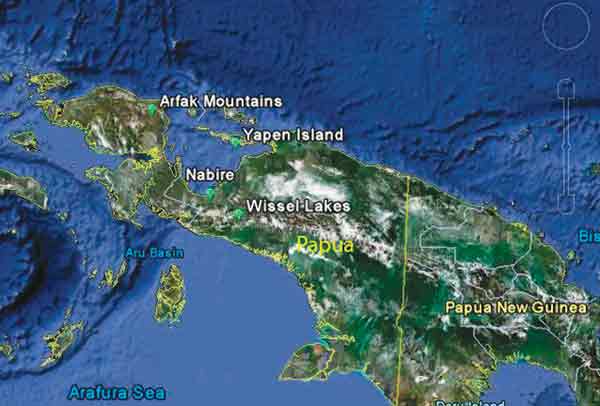
|
| Papua, Indonesian New Guinea |
Our first foray was to the village of Siobri on the seaward side of the Arfak Mountains on the Vogelkop Peninsula. The village itself was perched at about 1100 m (3600 ft) on the side of a mountain ridge. This area, because of its accessibility to Manokwari (about three hours on a relatively good road), had hosted foreign visitors before, mainly bird watching groups. We were slightly surprised to be presented with a list of prices of the various facilities including a substantial donation to "the village fund." These were negotiated to reasonable levels and in fact, we enjoyed the facilities of a weather proof hut, a supply of local fruit and vegetables and a very knowledgeable guide, Pak Zeth, who took us up the mountain on our first days collecting. We saw no rhododendrons in the secondary forest above the village but we eventually broke out onto a broad open expanse, spongy under foot from deep peat. This open area was probably due to burning from a lightening strike as there was no tree felling or gardening evident in the area. Prominent and common in the regrowth was the flamboyant Rhododendron konori Becc., with its beautiful large, white, powerfully scented flowers, sometimes spotted with pink at the base of the corolla lobes. Although one of the commonest and most widespread species in New Guinea, it is still a magnificent sight and one of the best species in cultivation for those that have room to grow it. Also growing in the opening was the small red flowered R. cililobum Sleumer. The small red flowered species are always of interest as they are rarely cultivated and often neglected, so that much less is known about them. Among the other attractive plants there was the large pink flowered Tecomanthe volubilis Gibbs, which has already been established as a successful cool greenhouse plant in temperate cultivation but which deserves to be more widely grown.
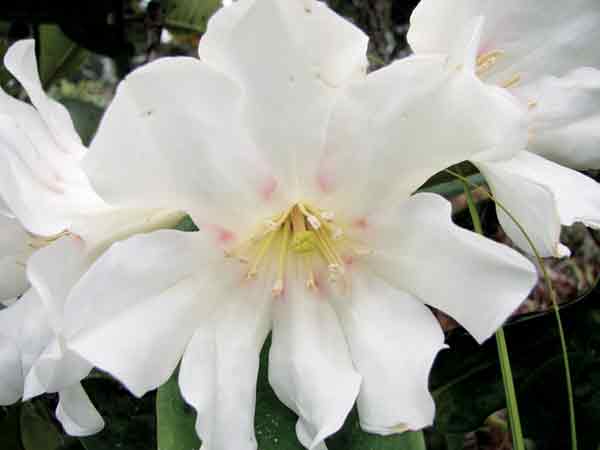
|
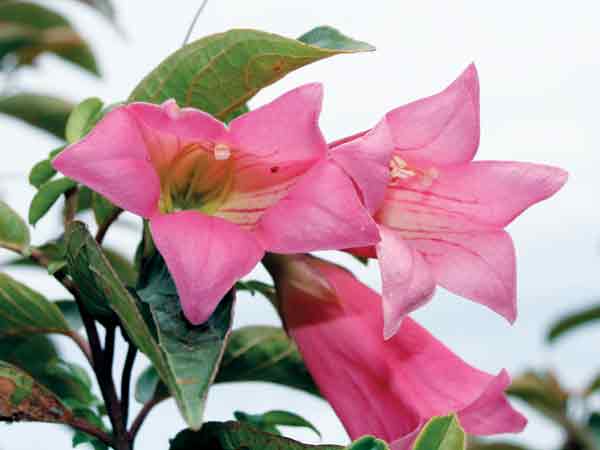
|
|
| R. konori | Tecomanthe |
Along the forest margin was the pink flowered R. arfakianum Becc. This was the first really exciting find, as although this species was introduced into cultivation by Professor Sleumer in 1962, all the plants in cultivation that have been checked recently have turned out to be hybrids. Thus, seeing the real species in the wild state was of particular interest. The first plants of this species we saw were all epiphytes growing in trees along the ridge. The delicate pink flowers were few and seed was non-existent, which was disappointing but we were later to see a great deal more of this species which often grew terrestrially and then attained as much as 5 m (16 ft) in height.
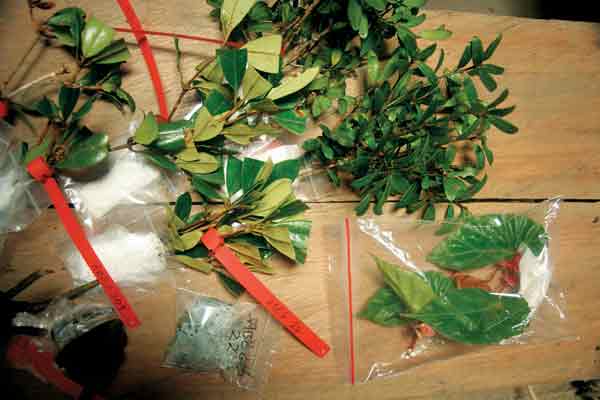
|
| Cutting material, wrapped in damp tissue and plastic bags. |
A problem in collecting living material on a long expedition is how to keep the material alive until it can be exported. Seed and spores are usually the best for long term carriage but even they need careful treatment. Vireya seed loses its viability very quickly if not dried well and kept dry, not the easiest of tasks in the very wet humid conditions in which the plants grow. Cuttings and seedlings are even more difficult to keep, which was why these early collections were considered experimental. Bases of both cuttings and seedings were wrapped in damp tissue and then polythene, leaving the upper portions open. They were sprayed with a mist sprayer whenever the opportunity allowed and kept in the light but out of direct sunlight. They were packed in locally purchased, rigid, plastic salad containers and kept for us in the air conditioned laboratory of the Forestry Department in Manokwari. We were surprised at how well, or badly, different things survived. Amongst the best were the cuttings of R. ciliilobum which looked remarkably fresh when we came to examine the material nearly three weeks later. Worst appeared to be the Tecomanthe , which had shed all its leaves, and the conifers appeared completely dead.
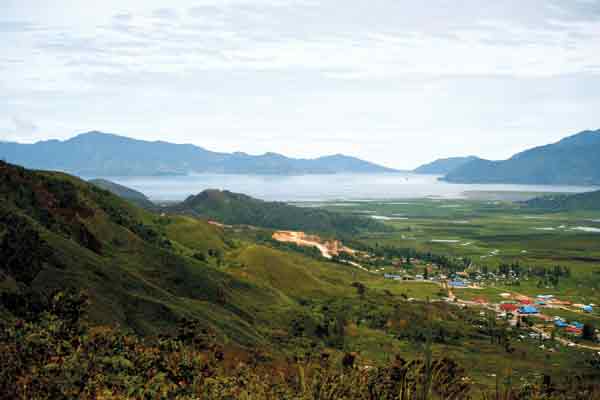
|
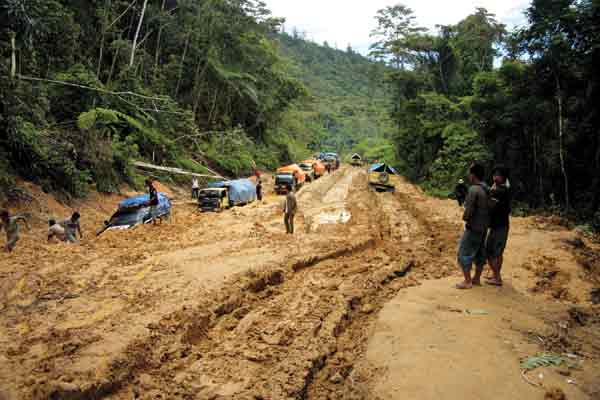
|
|
| View of Lake Paniai, the largest of the Wissel Lakes. | Road from Nabire to Enarotali |
We moved from Manokwari to Nabire, a large town further east along the coast, by a remarkably big and modern ferry. A new road had been built from Nabire to Enorakali, the main town in the Wissel Lake area. We were assured that this was passable with a four-wheel drive vehicle. We chose this instead of flying in as we understood that provisions would be very expensive or possibly unobtainable in Enoratali and the flights in were not cheap. It was always difficult to be sure we knew what the true circumstances were. We set off late in the afternoon - a curious time to start any journey, but we were told this would mean we would arrive at an important bridge very early the next morning ahead of other traffic. We travelled into the evening, stopping at a remarkably "western transport cafe" for an evening meal and then travelled on into the night on the rough, but mostly easily passable road. Not for too long, however, we stopped on a hill and the driver and his mate started to dismantle the driveshaft. We eventually found out that the four wheel drive was not working and that progress further was impossible without it being brought into operation. Of course it was never clear whether it had ever been working properly in the first place. We slept fitfully in the middle of a very quiet road and were rewarded with a magnificent dawn in the jungle, with hornbills and other wildlife viewing us with evident surprise. Eventually another vehicle arrived from the direction of Enoratali and after some negotiation, this driver agreed to turn round and take us on. We learned that the important bridge we had been aiming to arrive at around dawn was actually "out," but that the river was passable by a ford. The road deteriorated with ruts 1.2 m (four feet) deep, often filled with viscous brown mud. There was great camaraderie among the vehicle drivers, with one truck pulling the next through a particularly bad bit and then the pulled truck pulling the next in line. Sometimes the lines were many vehicles long and it sometimes took two hours to negotiate these "bad bits."
Eventually we got to "the bridge," and it was indeed "out." One side appeared to have collapsed, leaving the causeway canted at almost 45 degrees. The queue was over 100 vehicles long. Each vehicle in the queue was waiting to be painstakingly unloaded. The cargo was then carried across the distorted bridge by porters, and the vehicle was then driven into a steep ravine and up the other side, to be reloaded by hand before being able to drive away. Our driver nonchalantly drove to the head of the queue of vehicles and we were quickly across, in what otherwise could have been more than a day's delay. Ignorance is sometimes bliss and we later learnt that he had declared we were missionaries and must have priority! We supposed that plant hunters were missionaries of sorts.
We arrived at Enoratali late at night, eating in another café where proceedings were interrupted by a very irate gentleman wielding a knife, but fortunately his anger was not directed at us. We started the inevitable tour of offices the following day. Driving between these offices, we were impressed with the glowing spots of colour all over the hillsides provided by R. zoelleri Warb., another common but very spectacular species. We visited a local hill on which R. rappardii Sleumer, with white scented flowers was growing and flowering abundantly, together with colourful orchids, pitcher plants and a local Vaccinium (blueberry) whose flowers contained abundant nectar. The many small boys in attendance showed us that the flowers were good to eat. An exciting find was the hybrid between R. rappardii and R. zoelleri , with a lovely red star in the throat of an otherwise white flower.
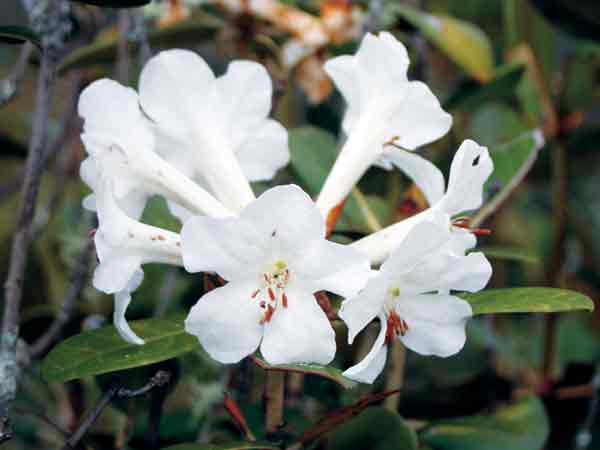
|
| R. rappardii |
The next day, having all the correct paperwork, we chartered a boat to cross to a village from where we wanted to work in the mountains. On arrival at the village, we had to wait for the elders to convene a meeting. We explained what we wanted to do, which was translated through two languages, and after much discussion, back came the elders' reply. "Sorry we can't allow you to collect." Apparently, young men who had worked at the large mine at Timika (five days walk away) told stories of the perceived atrocities of the mining company - desecration of vegetation and closure of traditional routes. There was nothing we could say to persuade them that we had nothing to do with mining, and so we had to turn round and return to Enoratali. The regional officials there were sympathetic but there was no way we could work without local village support.
A forest officer took us out the following day to collect along local roads. This was valuable in that we saw several additional species, but it was no substitute for the serious collecting that we had planned. The highlight in this area was finding R. cuspidellum Sleumer, a poorly known species with R. zoelleri -like flowers, although smaller and very distinct in other characters. It was curiously growing right alongside a large bush of R. zoelleri . We also saw a pink flowered R. rappardii , obviously a hybrid which accorded well with the report that this species had been known to cross with the dark red flowered R. rosendahlii Sleumer, as this latter species was also seen in the general area. We then flew back to Nabire, covering the distance of our two-day road journey inward in just 35 minutes. We were then glad we had fall-back permission to collect on Yapen island. This area was not nearly so rich in Rhododendron species but here we were greeted with a very friendly welcome from the villagers who found us as exotic as we found them. We did find R. glabrifilum J.J.Sm., sometimes considered a pink flowered form of the common and widespread R. macgregoriae F.Muell. It is hoped that this can be cultivated and its true status finally decided. We also found the bizarre Begonia bipinnatafida J.J.Sm., with its highly divided leaves, and many other interesting plants.
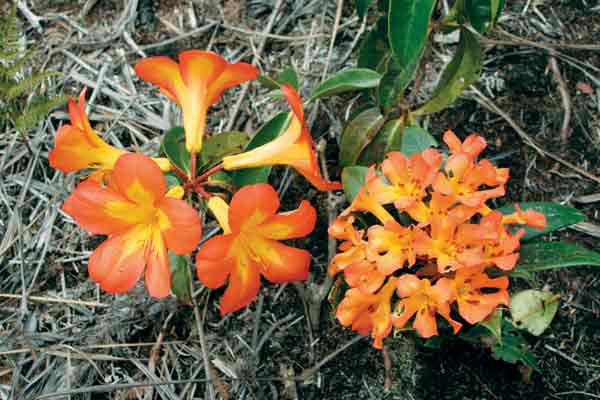
|
| R. zoelleri with R. cuspidellum |
We then returned to Manokwari on the mainland and decided to spend some of our remaining days collecting again in the Arfak mountains. We chose a different village but one still very accessible from the road. Here we found R. laetum J.J.Sm., growing both in the wild on the mountain ridges and cultivated in the village gardens. Very prominent also in a garden in front of a house was a giant R. konori about 1.5 m (five feet) high and as much across. We interviewed the villager who had the garden and he told us the plant was about 35 years old. It had been planted by his father who had collected it as a small plant from high on the mountain above the village. We also found some wonderful Dimorphanthera species. This is a genus very nearly endemic to New Guinea with about 70 species. Many are spectacular climbers with large, mostly pink or red flowers. This genus should be more widely grown but they are, like the vireyas, not frost hardy. We again returned to Mankokwari where we gave a presentation about the Edinburgh Botanic Garden and our expedition to the Forestry Department and members of the local university. We then packed our considerable plant collections and returned to Bogor, where we were given to understand the export permit would be granted within an hour of presenting the material to the relevant department. We committed it to the official driver and changed our air tickets to fly out the same night. To our utter amazement, we were told some hours later that permission to export had not been granted and would take at least two weeks and that we could not take the plants with us. A similar permit had been issued only the day before to another expedition. This we were told had been a mistake. We had to leave the plants in the hands of the staff of the Cibodas Botanic Garden who did a remarkably good job in keep our plants alive until nearly two months later when the permits were finally issued. They then packed the plants and couriered them to the U.K.
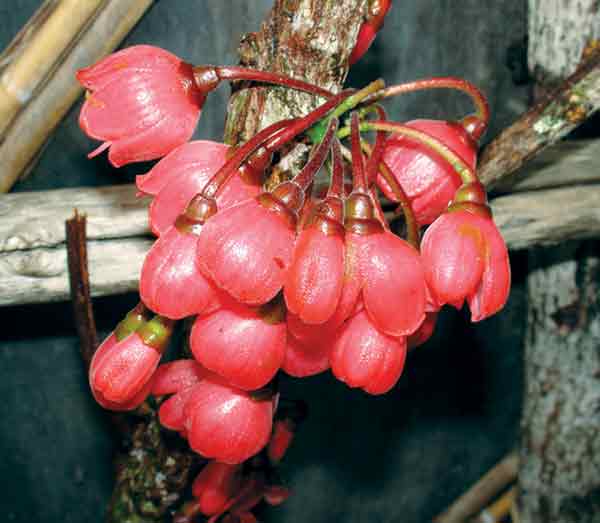
|
| Dimorphanthera |
We did not collect as many vireyas as we hoped and failed to find any new ones, but we made a lot of observations of the populations we did see in the field. Many other plants were new and will gradually be described and displayed. One can never put a price on the value of first hand experience and the benefit for international relations of meeting Indonesians at many different levels in their own country. Indonesians are amongst the most courteous people in the world and one has to appreciate that time-consuming bureaucratic procedures are also suffered by the local people as well as visitors to their country. What is also very apparent from mounting an expedition such as this is that wild-origin plant material is not getting any easier to collect. Habitats are becoming degraded, and there are increasingly restrictive bureaucratic procedures, or in our case misunderstanding of our intent by local villagers. Wild-origin material with a good provenance should be carefully nurtured and valued for what it is - a very valuable and not necessarily renewable resource.

George Argent is a member of the Scottish Chapter. He is a leading authority on vireyas having published a number of papers and books on their taxonomy, including a comprehensive book Rhododendrons of Sabah Malaysian Borneo.
